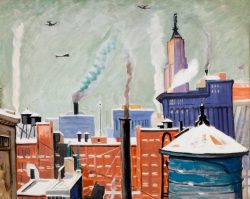Jean Crawford Adams 1886–1972
Jean Crawford Adams was born in Chicago and studied at the Art Institute, where her most important teachers were John Vanderpoel and George Bellows. Around 1920 Adams attended the Provincetown School of Art, in Provincetown, Massachusetts, run by Charles W. Hawthorne. Having made her debut in the Art Institute’s annual exhibitions in 1915, in 1925 Adams won a prize in the museum’s “Chicago and Vicinity” show. During two years of travel in Europe and the British Isles, she painted oils and watercolors and made woodcut prints. In Paris, she studied with André Lhote, who had founded his own art school in 1922. Adams returned to Chicago by 1928. That year, she exhibited with the No-Jury Society of Artists, staged a display of her recent work in the lounge of the Playhouse Theater, and showed several of her landscape paintings at the Woman’s World’s Fair at Chicago’s Coliseum. In 1930 the Art Institute’s “Room of Chicago Art” displayed twenty-eight paintings by Adams, a selection that traveled the following year to the California Palace of the Legion of Honor in San Francisco and the Los Angeles Museum of History, Science and Art (now the Los Angeles County Museum of Art).
In the next decade and a half Adams enjoyed considerable visibility both locally and nationally. In Chicago she belonged to a circle of modernist artists that also included Frances Foy and Laura van Pappelendam. They joined with others in 1929 to form The Ten, or 10 Artists (Chicago), holding annual exhibitions at the Marshall Field and Company department store until the early 1940s. Eleanor Jewett, the Chicago Tribune’s conservative critic, described Adams as the “enfant terrible” of the group.i Adams also showed her work in the annual exhibitions of the Pennsylvania Academy of the Fine Arts in Philadelphia and the Whitney Museum in New York, in the annual Carnegie International exhibitions in Pittsburgh, and with the Society of Independent Artists, the Salons of America, and the Arts Club of Chicago, among other venues. She was represented in the Whitney’s survey “Exhibition of Paintings and Prints by Chicago Artists” in 1933, the Art Institute’s Century of Progress loan exhibition the same year, and the Art Institute’s 1939–1940 survey “Half a Century of American Art.” In 1933, Adams won the museum’s Brower Prize in the “Chicago and Vicinity” show. She was one of numerous Chicago artists employed by the WPA’s Illinois Art Project, a federal government artists’ relief program of the 1930s and early 1940s.
Adams used a bold style of simplified flattened form, deliberately distorted perspective, and striking color. Her approach partly reflects the influence of her teacher Lhote, who had been among the radical French painters known as the Fauves (“wild beasts”) for their use of expressive color and line. Still-life images and landscapes dominated Adams’s subject matter. She painted pastoral Midwestern scenes, views of Provincetown, picturesque settings in France, and images of the Rocky Mountains and of scenery near Santa Fe. Adams remains particularly known for her paintings of Chicago, however. As she noted in her artist’s statement in J. Z. Jacobson’s Art of Today: Chicago, 1933, a compendium of Chicago modernist artists published in 1932, it was Chicago itself that had the greatest influence on her art.
Wendy Greenhouse, PhD
i Eleanor Jewett, “The Ten Meet Expectations in Annual Exhibit,” Chicago Tribune, Jan. 19, 1937.
